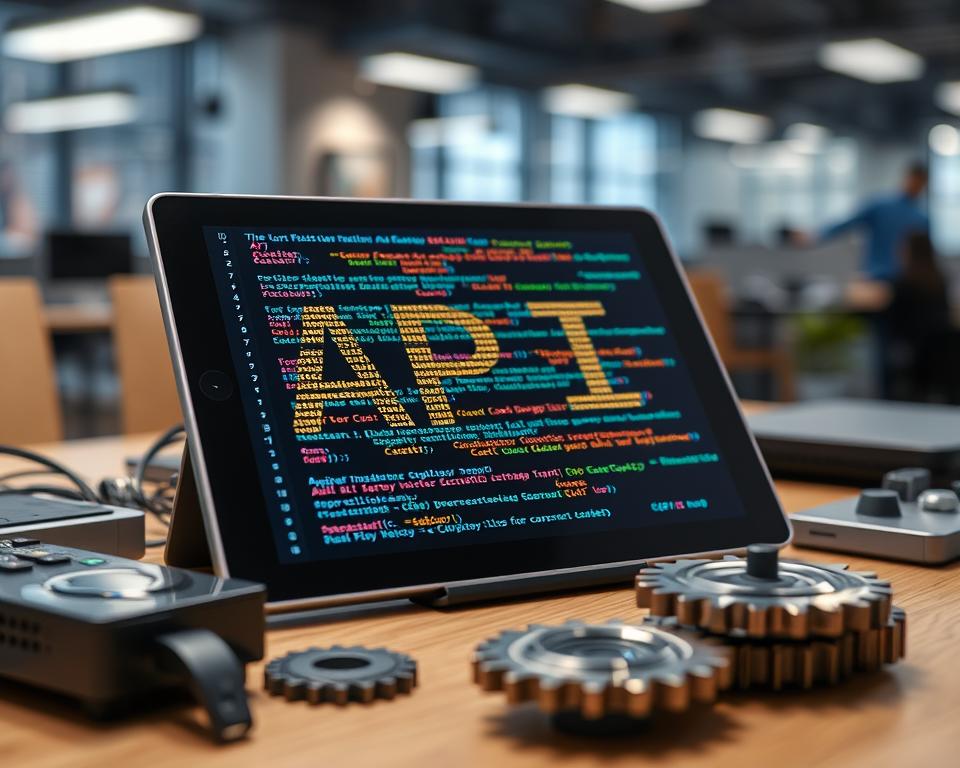Creating a mobile app is thrilling, but it can also surprise you with hidden costs. The first price tag might look good, but there are many hidden expenses. These include things like server costs, fees for third-party services, and maintenance. If you don’t plan for these, they can blow your budget.
In this article, we’ll look at the hidden costs of making a mobile app. We’ll also share tips on how to prepare for them. Knowing the real costs helps businesses plan better and avoid surprises. This way, they can make smart choices and keep their app successful over time. Let’s dive into the details and help you understand the costs of mobile app development.
Table of Contents
Key Takeaways
- Awareness of hidden costs is crucial for effective mobile app development budget planning.
- Unexpected expenses can quickly add up, leading to budget overruns if not properly accounted for.
- Understanding the true cost landscape, including infrastructure, backend, and ongoing maintenance, is essential for successful project management.
- Anticipating and planning for hidden costs can help businesses make informed decisions and ensure the long-term viability of their mobile app initiatives.
- Careful consideration of all potential expenses, from development to post-launch support, is necessary for a comprehensive mobile app development strategy.
Understanding the True Cost Landscape of App Development
Creating a mobile app is a detailed and complex task. The real costs often go beyond what was first thought. It’s key to dive deep into the costs of app development for good planning and management.
Initial Budget vs. Actual Expenses
One big challenge is the gap between the first budget and the real costs. This gap can come from underestimating how long it takes, missing hidden costs, or unexpected changes. Knowing these differences is vital for setting a proper development budget.
Common Cost Estimation Mistakes
Getting the cost estimation right is crucial but often tricky. Mistakes include not fully understanding the project, underestimating complex features, or forgetting about future updates. Fixing these mistakes leads to a better and more realistic project management plan.
The Reality of Development Timelines
Building a mobile app takes a lot of time and effort. The development timeline often doesn’t match the first plans. Technical issues, integration problems, and thorough testing needs can all cause delays. It’s important to plan for these delays to manage expectations and timelines well.
| Cost Factor | Initial Estimate | Actual Expense |
|---|---|---|
| Design and Wireframing | $10,000 | $12,500 |
| Frontend Development | $20,000 | $25,000 |
| Backend Development | $15,000 | $20,000 |
| Quality Assurance | $5,000 | $7,500 |
| Project Management | $8,000 | $10,000 |
By really getting the costs of app development, businesses can make smart choices. They can use resources well and ensure their app project succeeds in the long run.
Hidden Infrastructure and Server Costs
When making a mobile app, the costs of cloud infrastructure and servers are often missed. These expenses can quickly grow, affecting your budget and project’s growth. It’s key to know these costs for a successful app development journey.
Cloud Hosting and Server Expenses
Cloud hosting is a big cost in app development. The fees for hosting on services like AWS, Google Cloud, or Microsoft Azure can add up fast. You also need to think about server upkeep, software updates, and security patches for your app to run smoothly.
Scalability Considerations
As your app gets more users, you’ll need scalable servers. Scaling up can lead to more server expenses and hosting costs. Planning for scalability early can help avoid these costs later.
| Cost Factor | Average Expense Range |
|---|---|
| Cloud Hosting (monthly) | $50 – $500+ |
| Server Maintenance (annual) | $500 – $5,000+ |
| Scalability (per user/month) | $0.10 – $1.00+ |
Knowing and budgeting for these hidden infrastructure and server costs helps developers plan better. This ensures the long-term success of their cloud infrastructure.
Backend Development and Database Management Expenses
Building a strong backend for your mobile app is key, but it can be pricey. Costs include scaling databases, server upkeep, and API work. These expenses can quickly add up and affect your budget.
Scaling Database Costs
As your app grows, so does the demand on your database. Scaling it to handle more data and users is complex and costly. Costs include storage, computing power, and backup plans.
Server Maintenance Fees
Keeping your app’s backend servers running smoothly is vital but costly. You’ll need to pay for server checks, updates, security fixes, and support. These costs can grow as your app gets bigger and more complex.
API Integration Expenses
Adding external APIs to your app can also be pricey. You’ll face fees for API use, data transfer, and the time to set up and keep these integrations running.
Managing these backend costs is key to keeping your app budget healthy. Plan for growth, optimize servers, and choose API integrations wisely. This way, you can control costs and ensure your app’s success.
| Cost Category | Estimated Range | Key Considerations |
|---|---|---|
| Scaling Database Costs | $500 – $5,000 per month | Storage capacity, computing power, backup/recovery mechanisms |
| Server Maintenance Fees | $100 – $1,000 per month | Server monitoring, software updates, security patches, technical support |
| API Integration Expenses | $50 – $500 per month | API usage fees, data transfer charges, development time |
Third-Party Integration and API Licensing Fees
In mobile app development, using third-party services and APIs is common. These integrations add value and improve the user experience. However, they also come with hidden costs that can quickly add up. One major expense is the fees for API usage.
APIs let your app talk to external services and data. Many popular APIs, like those for mapping or payment processing, charge licensing fees. These fees depend on the API, usage level, and licensing terms.
There are also ongoing costs for API usage and third-party integrations. As your app grows, these costs can increase. This can add a lot to your development budget.
| API/Third-Party Service | Licensing Cost | Ongoing Usage Fees |
|---|---|---|
| Google Maps API | $0.50 per 1,000 map loads | $0.50 per 1,000 map loads |
| Stripe Payment Processing | 2.9% + $0.30 per transaction | 2.9% + $0.30 per transaction |
| Facebook Login | Free | None |
When planning your app’s budget, it’s key to research API licensing and third-party integration costs. Knowing these costs upfront helps manage your budget. It prevents unexpected expenses.
Hidden Costs in Mobile App Development: What to Watch Out For
Creating a successful mobile app involves more than just the initial costs. There are hidden expenses that can greatly affect your budget. We’ll look at three main areas where unexpected costs often pop up: team overhead, quality assurance, and project management.
Development Team Overhead
Creating a mobile app needs a skilled team, including designers, developers, and managers. While their salaries are part of the budget, other costs add up quickly. These include office space, equipment, software, and employee benefits. Ignoring these costs can lead to big budget problems and hurt the project’s profit.
Quality Assurance Expenses
Quality assurance (QA) is key for a smooth app experience. But, QA costs are often underestimated. This includes the time and tools for testing, and the cost of QA specialists. Not budgeting enough for QA can mean rushed testing and a bad user experience.
Project Management Costs
Good project management is vital for a successful app. It involves managing the team, stakeholders, and keeping the project on track. While the project manager’s salary is known, other costs are hidden. These include tools, software, and time for meetings and updates. Ignoring these can cause delays and budget issues.
Knowing about these hidden costs helps you plan your budget better. Make sure to budget for team overhead, QA, and project management. This will help your app launch successfully and profitably.
Security Implementation and Compliance Costs
Mobile app development is growing fast. It’s now key to have strong app security and follow compliance requirements. Setting up good security and making sure your app follows rules can be expensive. We’ll look at the hidden costs of cybersecurity and following rules in mobile app development.
First, think about adding strong data protection to your app. This means using secure login methods, encryption, and controlling who can access data. You’ll also need to pay for regular checks to find and fix security issues.
- Security audits and penetration testing
- Secure authentication and encryption protocols
- Compliance with data privacy regulations (e.g., GDPR, HIPAA)
Following rules specific to your app’s type, like HIPAA for health apps or PCI-DSS for finance apps, can also cost a lot. Getting the right certifications, setting up compliant systems, and keeping up with rules can use up a lot of your budget.
“Compliance is not just a box to check, but a critical component of building a secure and trustworthy mobile app.”
Also, hiring cybersecurity experts, either as team members or consultants, can be pricey. These experts are vital for making sure your app is secure and follows rules. But, their skills cost more.
In the end, spending on app security and following rules is a big part of making a mobile app. By knowing and planning for these costs early, you can make sure your app is safe, follows rules, and protects your users’ data and your brand’s image.
User Authentication and Data Protection Expenses
Creating a strong user authentication system and protecting data are key in mobile app development. These steps add costs that app makers need to consider in their budgets.
Security Audits
Regular security audits are vital to find and fix weaknesses in the app’s security. Experts thoroughly check the app’s code, setup, and how it handles data. The cost of these audits depends on the app’s complexity, the depth of the check, and the security firm’s skills.
Compliance Certification Costs
Developers might need specific compliance certifications, like HIPAA for health apps or PCI DSS for financial apps. Getting and keeping these certifications can be pricey. Costs include the initial process, ongoing checks, and updates to meet standards.
| Security Measure | Average Cost Range |
|---|---|
| Security Audits | $5,000 – $50,000 |
| Compliance Certification (HIPAA, PCI DSS, etc.) | $10,000 – $100,000+ |
Investing in authentication and data protection is key for keeping user trust and protecting sensitive info. Though these costs might seem high, they’re vital for a secure and compliant app to succeed in today’s market.
App Store Submission and Developer Account Fees
Getting your mobile app out there means going through a detailed process. You’ll need to submit it to app stores. This path comes with costs, like keeping developer accounts and making your app more visible.
The app store submission process can be pricey. Fees range from $99 to $299 a year for a developer account. These costs help manage your profile, app listings, and updates.
After setting up your developer account, you’ll face more expenses. App store optimization (ASO) is key. It means tweaking your app’s description, keywords, and looks to attract more users. ASO costs include market research, creating app screenshots and videos, and updating keywords and content.
| Platform | Developer Account Fee | Submission Fee |
|---|---|---|
| Apple App Store | $99/year | Free |
| Google Play Store | $25 one-time | Free |
| Amazon Appstore | $99/year | Free |
Dealing with app store fees and rules can be tough. But knowing these costs early helps you plan your app budget better.
“Ensuring your app is optimized for the app stores is crucial for visibility and downloads. It’s an ongoing process that requires careful attention and strategy.”
Marketing and User Acquisition Costs
Creating a successful mobile app is more than just coding and design. Marketing and user acquisition costs are huge. These expenses are often overlooked but are crucial for app success.
App Store Optimization Expenses
App Store Optimization (ASO) is key to your marketing strategy. It includes keyword research, content optimization, and visual asset curation. These tasks need time, effort, and money. Ongoing ASO is vital to stay competitive in the app market.
Promotional Campaign Budgets
Getting users to your app is a big challenge. Promotional campaigns like social media, influencer outreach, and targeted ads are crucial. They need a lot of money to reach the right people and get downloads. Without enough money for app marketing, your app’s success is at risk.
Success in mobile app development means more than just a great product. It’s also about promoting and acquiring users. Ignoring ASO and promotional costs can lead to financial surprises. It can also hurt your app’s success.
| Expense Category | Estimated Cost |
|---|---|
| App Store Optimization | $2,000 – $5,000 per year |
| Promotional Campaigns | $10,000 – $50,000 per year |
| Total Marketing and User Acquisition Costs | $12,000 – $55,000 per year |
“Acquiring users is the biggest challenge for mobile app developers. Ignoring marketing and user acquisition costs can lead to the downfall of even the most innovative apps.”
Ongoing Maintenance and Updates
Creating a mobile app is just the start. To keep it successful, you need ongoing app maintenance and updates. This means fixing bugs, adding new features, and keeping the app running smoothly.
Keeping your app up to date is key to happy users and avoiding big problems later. It involves watching for security issues, fixing them fast, and updating the app for new devices and systems.
- Fixing bugs and addressing user reports
- Updating the app to work with the latest OS and hardware changes
- Enhancing features based on user feedback and market trends
- Optimizing app performance and user experience
The costs of keeping your app updated can add up over time. It’s important to plan for these expenses to keep your app going strong.
By focusing on app maintenance and meeting user needs, your app stays relevant and valuable. A solid maintenance plan is essential for your app’s long-term success.
Performance Monitoring and Analytics Tools
Mobile app development is always changing. It’s not just about the initial cost. You also need to think about the cost of performance monitoring and analytics tools. These tools are key to your app’s long-term success.
Real-time Monitoring Solutions
Real-time monitoring tools are crucial for tracking your app’s performance. They help spot issues early on. This way, you can fix problems before they affect your users.
The cost of these tools varies. You might pay a monthly or yearly fee. You’ll also need time and resources for setup and management.
User Behavior Analysis Costs
User behavior analysis tools are also vital. They show how users interact with your app. This includes how long they stay, what they do, and more.
Investing in these tools helps you make better decisions. You can update your app, add new features, and target your marketing better. The cost includes licensing fees and the time to understand and act on the data.
| Solution | Key Features | Estimated Cost |
|---|---|---|
| New Relic | – Real-time performance monitoring – Application analytics – Distributed tracing |
$99 – $299 per month |
| Mixpanel | – User behavior tracking – Funnel analysis – Cohort analysis |
$25 – $150 per month |
| Crashlytics | – Crash reporting – Beta testing – Stability monitoring |
Free (part of Firebase) |
By using app performance monitoring and user behavior analysis tools, you can improve your app. You’ll get insights to make your app better, enhance the user experience, and achieve long-term success.
Customer Support Infrastructure
Offering excellent customer support is key for any mobile app’s success. Yet, the costs of setting up a strong customer support infrastructure are often ignored. This includes help desk systems and various support channels, which can quickly increase your budget.
Setting up a help desk system is a big part of the cost. These platforms offer ticket management, knowledge bases, and automated responses. The price varies based on your app’s user assistance needs. You also need to consider the cost of training and keeping a team of customer support reps.
Mobile apps often need different support channels to meet user needs. This includes live chat, email, social media, and in-app support. Each channel has its own costs, from subscription fees to staffing and management.
Adding customer support features to the app can also increase costs. This might include in-app chat, feedback tools, or self-service troubleshooting. These features improve user experience and help the help desk team, making the customer support system more efficient.
In conclusion, creating a solid customer support system for a mobile app needs careful planning and budgeting. Knowing these hidden costs helps app developers prepare for the true costs of providing top-notch user assistance. This ensures the app’s long-term success.
Content Creation and Management Expenses
Mobile app development costs are growing, especially for content creation and management. These costs include making multimedia assets and updating content. They can quickly increase your budget.
Multimedia Asset Development
Creating engaging multimedia content is key for mobile apps to shine. This includes images, videos, animations, and infographics. The price varies based on complexity and design.
Content Update Costs
Keeping your app’s content fresh and relevant is vital. But, updating app content regularly can be expensive. These costs include new content and content updates. They are often forgotten in the initial budget.
| Cost Factor | Estimated Range |
|---|---|
| Multimedia Asset Development | $5,000 – $50,000+ |
| Content Update Costs | $500 – $5,000 per update |
Knowing and planning for these content creation and management expenses helps keep your app on budget. It also ensures a great user experience.
“Effective content management is the key to unlocking the full potential of your mobile app.”
Cross-Platform Development Considerations
In mobile app development, choosing between cross-platform or native apps affects costs and time. Cross-platform apps use one codebase for many platforms, saving money and speeding up release times. Yet, it’s vital to grasp the subtleties and hidden costs of this method.
Choosing between hybrid and native frameworks is a key cross-platform decision. Hybrid apps use web tech like HTML, CSS, and JavaScript, saving on development costs. However, they might not match the performance and user experience of native apps. Native app development offers top-notch performance and user experience but comes with higher costs and longer development times.
| Criteria | Native App Development | Cross-Platform Development |
|---|---|---|
| Development Cost | Higher | Lower |
| Development Time | Longer | Shorter |
| User Experience | Excellent | Good, but may be less polished |
| Performance | Superior | Good, but may be less optimized |
| Customization | Highly customizable | Slightly less customizable |
When looking at cross-platform development, hidden costs are important to consider. These include specialized skills, extra testing, and performance compromises. With careful planning and research, you can make a choice that fits your project’s needs and budget.
Testing and Quality Assurance Expenses
In the world of mobile app development, testing and quality assurance are key. They ensure a smooth user experience. But, the costs of these processes are often overlooked or underestimated. From app testing to quality assurance, the expenses can quickly add up. It’s important for app developers to plan and budget well.
Beta testing is a crucial testing method. It involves releasing the app to a select group of users for feedback and bug identification. This process helps catch issues before the final launch and gives insights into user behavior and preferences. The costs include recruiting testers, offering incentives, and managing the feedback loop.
User acceptance testing (UAT) is another key quality assurance aspect. It tests the app with a representative sample of the target audience. This step ensures the app meets user expectations and requirements. However, it can be time-consuming and require additional resources, like specialized testing facilities and user recruitment.
| Testing Methodology | Key Considerations | Estimated Costs |
|---|---|---|
| Beta Testing |
|
$5,000 – $20,000 |
| User Acceptance Testing (UAT) |
|
$10,000 – $50,000 |
Understanding the true costs of app testing, quality assurance, beta testing, and user acceptance testing helps app developers plan better. They can ensure their mobile applications meet high standards of quality and user satisfaction.
Conclusion
Mobile app development is complex and full of hidden costs. These can quickly increase your budget. Costs include infrastructure, server expenses, third-party integrations, and security compliance.
To manage these costs, you need a solid mobile app budget planning, cost management, and development best practices. This way, your app project stays on track financially and strategically. Planning ahead, doing thorough research, and being open to changes are key to a successful app within your budget.
Creating a great app is not just about looks and function. It’s also about managing costs for long-term success. Stay alert and take a comprehensive approach to overcome hidden challenges. This way, you can fully realize your mobile app’s potential.



















